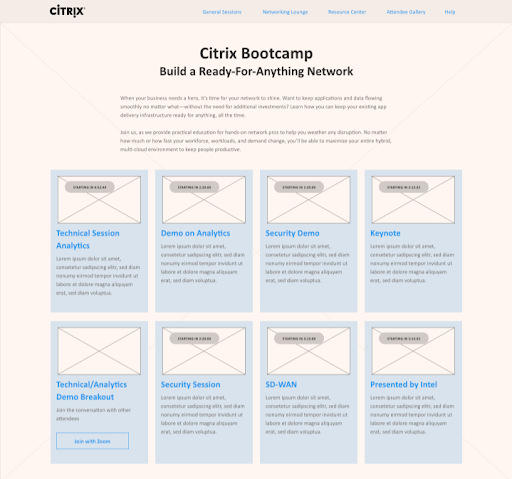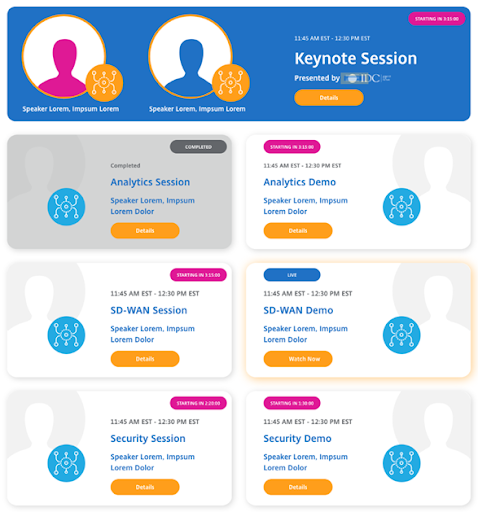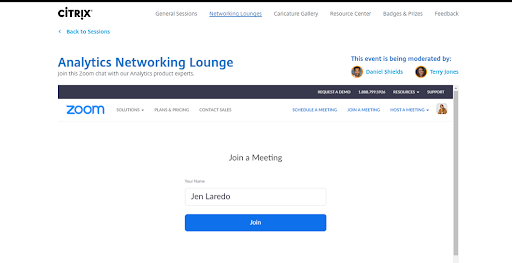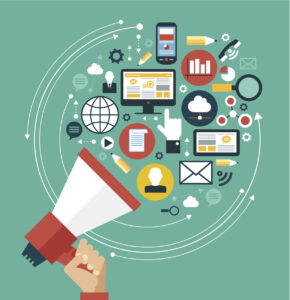There’s no doubt that the past five months have looked quite different from what we’re used to. Each day, we log onto our computers, join video conferencing lines, and do our best to make this new virtual work-from-home experience feel as in-person as possible. Day to day social situations may have been put on pause, but business certainly has not. Happy hours with coworkers? Via Zoom. Pivotal presentations with clients? Via WebEx. In-person large events and seminars? We have a solution for you.
Just two short months ago, Citrix turned to Bluetext to help bring one of their networking events into a completely virtual space. The Citrix team had one goal: create a seamless virtual experience that provided the same quality of content and connectivity as an in-person event.
With only six short weeks to build a fully custom microsite complete with new, event-specific branding, Bluetext hit the ground running.
First, came the wireframes. In order to fully understand the user journey, the Bluetext UX and design team worked closely with Citrix to understand their virtual event goals, which included providing a seamless user journey and navigation. Just as each in-person event has a lobby, there needed to be a ‘home dashboard’ where users could easily access all relevant sessions on the day of the event. With a maximum of eight general sessions, we explored a few different possibilities for displaying the session information.
 Ultimately, we landed on our two-column grid with a featured keynote session. This enabled us to include as many relevant details as possible, including a countdown clock that would show a user how much time was remaining until a certain virtual event session begins. Think of an in-person event: any attendee would have been provided an agenda of events, along with locations and maps. The same guidance and resources need to be readily accessible in a virtual event. Through the selected UX, the homepage of Citrix Boot Camp could provide a high-level overview of the event’s itinerary. We explored a grayed-out ‘completed’ state for each session, which gave users the signal that the session has completed.
Ultimately, we landed on our two-column grid with a featured keynote session. This enabled us to include as many relevant details as possible, including a countdown clock that would show a user how much time was remaining until a certain virtual event session begins. Think of an in-person event: any attendee would have been provided an agenda of events, along with locations and maps. The same guidance and resources need to be readily accessible in a virtual event. Through the selected UX, the homepage of Citrix Boot Camp could provide a high-level overview of the event’s itinerary. We explored a grayed-out ‘completed’ state for each session, which gave users the signal that the session has completed.
 Not only was it important to create simple and seamless UI and UX that would provide all registrants an intuitive experience, but it was just as important to make the event feel as lively as possible. With no physical event staff to welcome, direct, or answer questions, the website had to serve any and all personal touches one would expect. Bluetext designed a pair of pre- and post-event thumbnails to display before and after the live video play to transform the event microsite into an exciting and lively virtual space for all registrants.
Not only was it important to create simple and seamless UI and UX that would provide all registrants an intuitive experience, but it was just as important to make the event feel as lively as possible. With no physical event staff to welcome, direct, or answer questions, the website had to serve any and all personal touches one would expect. Bluetext designed a pair of pre- and post-event thumbnails to display before and after the live video play to transform the event microsite into an exciting and lively virtual space for all registrants.
Once we had a beautiful site ready for build, our team began to work through a major development goal of the site: the live-video playback. Our team leveraged the Zoom integration to provide live Q&A sessions for registrants to engage directly with Citrix representatives. This gave users the traditionally intimate networking experience that is generally lost when transitioning events into the digital world.
Read Part 2 of our Behind the Scenes of Citrix Boot Camp here.

Looking to reinvent your company’s event experience? Bluetext can help. Contact us today.
- The COVID-19 Pandemic has expanded the “stay at home” audience for B2B businesses.
- The commercial sector has seen changes in how audiences are reacting to content and consuming media.
- Capturing these audiences will require businesses to adapt content and tactics to the current climate.
Over the past few months, we have all adjusted to new living and working environments. This means varying working hours, virtual gatherings and different web surfing, streaming and social networking habits. These changes have shifted the traditional marketing audience profile.
If your business is B2B, you should be aware of these audience changes and adapt your marketing tactics to keep up with the current trends. Here are a few ways that you can make sure your message doesn’t fall flat with the new “stay at home” audience.
If your business is more B2B and your target audience is a specific position type in a company, your audience might have shifted even more than a typical consumer audience. Now, instead of doing research at work, many employees are browsing, doing research and consuming media at all hours at home. This can make it more difficult to target by company IP address, for example, but can make it more likely that you get valuable leads from social media sites like Facebook and LinkedIn.

The common threads that businesses are searching for during this time are supply chain management, eCommerce, website tips and management, point of sale transactions and financial support. Focus not only on your value add for customers, but also on the unique ways you’ll support them during this time.
Lift the Gate!
Just like consumer-focused businesses, it’s a good idea to offer some sort of additional value for business customers. It can be a draw for businesses to find free thought leadership content or resources on your site – even if it’s content that you would normally have gated.
Shifting Media Channels
For B2B businesses, digital media channels are seeing a serious uptick in volume and inventory. This shift may be an even greater shift for B2B industries as channels are seeing more traffic from business-people who would normally not be as active on social media in the middle of the day.
Another result of this pandemic is that trade shows and conferences have been canceled or are going virtual. With 53% of B2B marketers considering in-person events and tradeshows an effective channel for driving conversion according to eMarketer, this can be an important change to take advantage of. Many businesses (28% according to Smart Insights) are putting a positive spin on this shift and reinvesting trade show budgets into digital advertising.

Target Audience Hours
The shift to remote work has made it more likely that employee’s hours will shift from the traditional 9-5. This provides a unique opportunity for hour extensions for both B2C and B2B campaigns.
While no one is positive how long the effects of this pandemic will last, it is clear that the stay at home orders are changing how both consumer and business audiences are consuming media. Businesses must adapt to these changing audience behaviors and characteristics, not only to survive now but to better understand and cater to their target customers in the future. Need help capturing your changing audience? Call Bluetext.
The lunch options surrounding our offices are, shall we say, limited. Perhaps this is one reason the line for Sweetgreen during peak lunch hours can run a solid twenty-minute wait. Diners, myself included, wait until we are ready to eat lunch to get the salad, hence the long line. Now what prevents me, or anyone else for that matter, from running out to get my salad at 11am, when the place is completely empty?
It’s a salad after all. I can stick it in the fridge and eat it whenever I want. One could ask the same question about how we purchase clothes at stores (which old-timers like myself still do). Around this time of year when stores are pushing summer clothes, the sale racks are filled with heavily discounted fall and winter wear – probably the same winter clothes you paid double or triple for just a few months ago. But no matter how enticing the sale, we often bypass the out-of-season sale items in favor of what we will wear in the here and now.
Both of these examples came to mind as I started thinking about how businesses market their products and services to – whether its b2b, b2g or b2c. You not only have to hit prospective new customers you want to convert and existing customers you want to upsell with the right message, but it has to be the right message at the right time. The right time, as is the case with winter clothes on sale as summer begins, often comes down to when prospects and customers are in the frame of mind to be thinking about your product or service. Catch them too early and they will get distracted and move on; catch them too late and, well, that’s self-explanatory I suppose.
This challenge becomes more difficult for marketers trying to blanket a large number of customers and prospects. The ability to personalize the message and the timing is why more marketers are increasingly intrigued by Account-based marketing (ABM). With ABM you concentrate efforts on a very defined set of target accounts within a market, and then utilize campaigns personalized down to the single account level.
Marketing automation leaders are also looking at ABM to round out their services portfolio. Recently inbound marketing and sales leader HubSpot invested in ABM startup Terminus as part of a $10.3 million Series B round. In its blog explaining motivation for the investment, HubSpot talks about the fact that while inbound marketing is valuable for targeting an individual throughout the purchase process and beyond, ABM is useful when there is a need to build a relationship with multiple stakeholders at once. When done right HubSpot notes, ABM is about “precision and personalization not brute force.”
If you are a CMO thinking holistically about marketing to b2b, b2c and b2g customers, Account- based marketing has earned some mindshare. Altera Group research finds that 97% of marketers surveyed said that ABM has a somewhat higher or much higher ROI than other marketing initiatives. And in its 2016 State of ABM study, market research firm SiriusDecisions found 70% of B2B companies are beginning to build ABM programs, while 87% of participants said ABM is extremely or very important to their marketing efforts.
Marketo recently highlighted five key benefits of ABM, and I think they’ve hit the nail on the head:
- Clear ROI – Effective ABM drives clear business results. In fact, compared to other marketing initiatives, the 2014 ITSMA Account-Based Marketing Survey found that “ABM delivers the highest Return on Investment of any B2B marketing strategy or tactic.”
- Reduced Resource Waste – Because ABM is so targeted, it allows marketers to focus their resources efficiently and run marketing programs that are specifically optimized for target accounts.
- It’s Personal and Optimized – ABM entails personalizing your messaging and communications to specific accounts so that your campaigns resonate with these target audiences. Targeted customers are more likely to engage with content that is geared specifically to them, and is relevant to their business and stage in the buyer journey.
- Tracking Goals & Measurement is Clear – When you’re analyzing the effectiveness of campaigns, whether email, ads, web, or events, it’s easier to draw clear conclusions, because you look at a smaller set of target accounts instead of a vast set of metrics.
- Sales Alignment is Easier – ABM is perhaps one of the most efficient ways to align sales and marketing. This is primarily due to the fact that the marketer running an ABM program operates with a mindset very similar to sales—thinking in terms of accounts and how to target them, bring them to the table, and generate revenue from them.
Account-based marketing can help you reach the right prospect and customer with the right message at the right time. It’s 10am, so I’d love to tell you that I’m off to go buy my salad while no one is in line but…
Have a marketing or communications challenge? Contact us. We can help!
When it comes to where a brand should spend its video ad dollars, YouTube has long been the go-to destination. With more than 3 billion video views per day, content producers direct the majority of its efforts here – and unsurprisingly the advertiser budgets have followed.
But this presumption is being seriously tested by a video traffic explosion – chronicled in great detail by Fortune magazine writer Erin Griffith – underway at Facebook. Facebook users are watching 4 billion video streams a day, which is a 4x jump from just twelve months ago. Granted, Facebook counts a “view” as any video that plays for three seconds, which means that users scrolling down their feed and allowing a video to briefly auto play before moving on inflates the view total. Nonetheless, 4 billion is 4 billion.
Fortune’s Griffith goes into some of the reasons behind social network’s video success – which unsurprisingly includes efforts by engineers to adjust algorithms that make it not only easier to watch videos, but also to share them. While Griffith’s focus is on how all of this impacts advertisers and where they spend their money, Facebook’s rapidly growing impact with video presents a conundrum for B2B and B2G brands and the public relations/marketing firms that represent them.
In evaluating the major social networks and where to focus resources, investment and, most importantly, content, Facebook typically comes up last for firms seeking to influencer decision makers across government and businesses. Sure, everyone is on Facebook, so it goes, but the working assumption is that the largest social network is where you go to view new pics of the grandkids or post updates from the beach – not to consume B2B/B2G focused content.
Griffith’s article supports as much when it comes to videos, with the author pointing out that, “…Facebook’s biggest advantage over YouTube and other video providers may be boredom.” Griffith suggests someone lands on a YouTube video either because they are searching directly for it or a related topic, or a video being shared is ultimately sourced on that site. With Facebook, most of the time we are watching videos because we are killing time on the site and it is just another thing to do.
Because Bluetext works with so many B2G and B2B firms, social media strategy comes up quite a bit. Often, recommendations lean towards LinkedIn, Twitter and YouTube depending on the ultimate goal and category of decision makers the client is trying to reach. Even with B2B and B2G clients for whom we are not supporting social media, Facebook is usually trailing the pack in their social efforts.
But the fact is that Facebook drives one-quarter of all web traffic, and its video traffic explosion demands B2B and B2G firms reevaluate how best to use the site with video content. Is it ideal for placing corporate marketing, event or deeply technical product and service videos? No, absolutely not. But are there times when Facebook, rather than YouTube, should be ground zero for launching a more consumable brand humor video or engaging content that can be easily viewed – and shared – across Facebook and then on to other destinations? 4 billion video streams a day say yes, and going forward B2B and B2G brands may be saying yes as well.